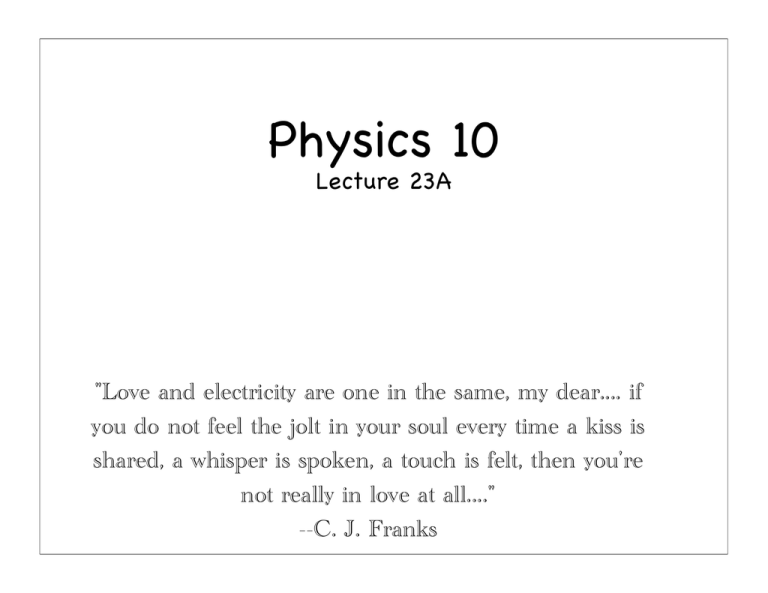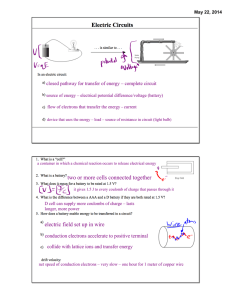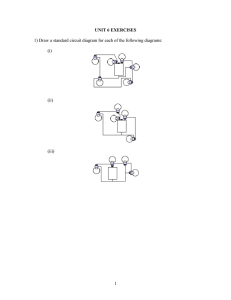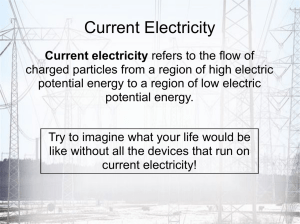Lecture 23A
advertisement

Physics 10 Lecture 23A "Love and electricity are one in the same, my dear.... if you do not feel the jolt in your soul every time a kiss is shared, a whisper is spoken, a touch is felt, then you're not really in love at all...." --C. J. Franks Current Up until now, we have dealt with electrostatics (i.e. charges that do not move). We now define electric current, I, to be the rate at which electric charge passes through a surface or volume. The SI unit for current is the Ampere. Current What causes electric current to flow? An electric potential difference, usually created by some sort of battery. The battery uses chemical energy to create ΔV. Current is defined as positive charges moving in a certain direction. I + + + If negative charges are actually moving, then current is defined as moving opposite to the motion of the negative charges. I – – – Current What physically flows through wires: positive charges or negative charges? It is the tiny electrons that move in the wire. They move more easily than the massive protons. But due to historical reasons, we use positive current when performing calculations. How fast do electrons move in a wire under current flow? Not fast at all, electrons move about 0.5mm/s in a conducting wire. Current Current If electrons move so slowly, then why do lights turn on exactly when I hit the switch? The electron at the switch isn’t the one that will give energy to the lights. When you turn on a light switch you are establishing an electric field that moves all the free electrons in the wire circuit. You need a closed loop with the wire. An open loop means no electric field and no current flow. This is known as an open circuit. Current There are two types of current flow. Direct Current (DC) is current that flows in one direction. Alternating Current (AC) moves back and forth. The sources of DC must be constantly providing energy or voltage (such as a battery). The sources of AC must be switching energy to push one way, then another. Generators and alternators provide AC. Current When a battery is placed in a closed loop an electric field is established inside the conducting wire. This electric field starts on the positive terminal and ends on the negative terminal. Positive charges will move with the electric field toward the negative terminal. When the circuit is open, the positive charges don’t see a negative terminal and thus, no current. Batteries The cause of current flow is an electric potential difference, ΔV. Batteries supply energy to keep “pumping” charge carriers. We term this “pumping” as emf, ɛ. (It stands for electromotive force, problem not a force). Most materials do not like charges to flow through them. They are said to resist current as it tries to flow through them. We define this property as electrical resistance. Resistors Resistance comes from friction (electrons rubbing on electrons). You can increase the resistance of a resistor by either increasing its length (more friction) or decreasing its area (less pathways). A thin wire has a greater resistance than a thick wire and a long wire has a greater resistance than a short wire. When current flows through a resistor, it can heat up quickly. Some resistors heat up so much that they glow, this is how the light bulb was created. Ohm’s Law No matter how good your conductor is, you are always going to have a minute slowing of current due to the conductor. Ohm’s Law quantifies the ability of a given material to resist the flow of charge for a given electric potential difference. where R is called the resistance and is measured in Ω (Ohm’s). [Ω] = [Volt]/[Ampere] Ohm’s Law Ohm’s Law is not really a law in the technical sense. It merely defines the resistance for certain materials. Certain materials obey Ohm’s Law, these are called ohmic materials. There is a linear relationship between current and electric potential. Certain materials do not obey Ohm’s Law, these are called nonohmic materials. Ohm’s Law A good conductor will have a low resistance, this means that current will easily flow through it. A good insulator will have a high resistance, this means that current will have a very hard time flowing through it. With Ohm’s Law, as you increase electric potential (ΔV), then current will increase linearly. The brightness of a light bulb will be represented by the electric power of the light bulb: Power = current × voltage Household Circuits In your house, you have parallel wiring between your appliances. If you had wiring in series, if one light bulb went out the whole house would stop consuming power (not a complete circuit). Each appliance is independent of the others. The power company supplies 120V of electric potential. Also, if current were to get too high (~100A), the wires would physically melt. Household Circuits To avoid this, fuses are available on every circuit. Fuses disconnect circuits (make them open circuits) when current gets too high (Fuses typically blow at about 10A). Caution: Never become part of a household circuit. Death can occur at about 1A. Especially be careful of cuts on the skin around electricity. Dry skin has a resistance of about 1MΩ, but just under your skin you have a resistance of about 10Ω. Circuits Light bulbs are resistors that you can measure the power dissipated by them with their brightness. The brighter the bulb, the more power dissipation of the light bulb. I have two light bulbs, one 100W and one 60W. If I hook them up separately to the a given battery which one will be brighter? Correct, the 100W bulb was brighter! What if I hook them up in series to the same battery, which one will be brighter then? Clicker Question 23A-1 I have two light bulbs, one 100W and one 60W. If I hook them up in series to the same battery, which one will be brighter? A) The 100W bulb. B) The 60W bulb. C) They will have the same brightness. D) It doesn’t matter what power rating they have it will always be the one that is closest to the positive terminal of the battery. Circuits The 60W????????????????? Realize that the power rating on light bulbs only represent the power dissipated when they are plugged into the wall. A 100W bulb will not always put out 100W of power dissipation. You have to know what the potential difference source is and what other elements are in the circuit. When examining a circuit you need to know all of the elements in the circuit (think globally). For Next Time (FNT) Read Chapter 24. Start the homework for Chapter 23.





